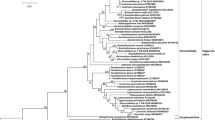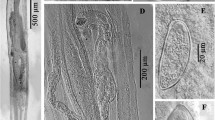Abstract
The Chinese alligator Alligator sinensis Fauvel (Reptilia: Crocodylia) is considered as one of the most critically endangered species of the 23 extant crocodiles. However, our knowledge of the helminth parasites of this rare animal is completely lacking. During a helminthological survey of reptiles in China, we found a new ascaridoid nematode, Dujardinascaris gigantea sp. n. from A. sinensis. The morphology of D. gigantea sp. n. was studied using light and scanning electron microscopy. The new species was also characterised using molecular methods by sequencing and analysing the small ribosomal DNA (18S) and the second internal transcribed spacer (ITS-2).



Similar content being viewed by others
References
Baylis HA (1923) On the classification of the Ascaridae. III. A revision of the genus Dujardinia Gedoelst, with a description of a new genus of Anisakinae from a crocodile. Parasitology 15:223–232
Baylis HA (1947) The nematode genus Dujardinascaris (nom. nov. pro Dujardinia) in Crocodilia, with a description of a new species. Ann Mag Nat Hist 14:123–134
Ding YZ, Wang XM (2004) Factors influencing the population status of wild Chinese alligators (Alligator sinensis). Biodivers Sci 12:324–332
Floyd RM, Rogers AD, Lambshead JD, Smith CR (2005) Nematode-specific PCR primers for the 18S small subunit rRNA gene. Mol Ecol Notes 5:611–612
Li L, Du L-Q, Xu Z, Guo Y-N, Wang S-X, Zhang L-P (2014) Morphological variability and molecular characterisation of Dichelyne (Cucullanellus) pleuronectidis (Yamaguti, 1935) (Ascaridida: Cucullanidae) from the flatfish Pleuronichthys cornutus (Temminck & Schlegel) (Pleuronectiformes: Pleuronectidae) in the East China Sea. Syst Parasitol 87:87–98
Machida M, Araki J, Regionel PA, Pontillas FA, Kurata Y (1992) Three species of ascaridoid nematodes from crocodile in the Philippines. Bull Natn Sci Mus Tokyo Ser A 18:95–102
Mahmoud NEE (1999) Crocodiles as a source of nematode larval infestation among fish species in Lake Nasser, Egypt. Assiut Vet Med J 40:88–102
Moravec F (2001) Some helminth parasites from Morelet’s crocodile, Crocodylus moreletii, from Yucatan, Mexico. Folia Parasit 48:47–62
Moravec F, Jirků M (2014) A new ascaridoid nematode, Dujardinascaris mormyropsis sp. n. (Nematoda: Anisakidae), from the osteoglossiform fish Mormyrops anguilloides in Central Africa. Syst Parasitol 88:55–62
Sprent JFA (1977) Ascaridoid nematodes of amphibians and reptiles: Dujardinascaris. J Helminthol 51:253–287
Sprent JFA, McKeown EA, Cremin M (1998) Dujardinascaris spp. (Nematoda: Ascaridoidea) in Old World crocodilians. Syst Parasitol 39:209–222
Tellez M (2013) Checklist of host-parasite interactions of the order Crocodylia. University of California Press, Los Angeles, 390 pp
Thorbjarnarson J, Wang X (2010) The Chinese alligator, ecology, behaviour, conservation and culture by J. Baltimore: The Johns Hopkins University Press, Baltimore, p 268
Thorbjarnarson J, Wang X, Ming S, He L, Ding Y, McMurry ST (2002) Wild populations of the Chinese alligator approach extinction. Biol Conserv 103:93–102
Travassos L (1933) Sobre os Ascaroidea parasitos dos crocodilos Sul-Americanos. Ann Acad Brasil Sci 5:153–169
Wan Z, Gu C, Wang X, Wang C (1998) Conservation, management and farming of crocodiles in China. Pp. 80-100 in Crocodiles. Proceedings of the 14th Working Meeting of the IUCN-SSC Crocodile Specialist Group. IUCN: Gland
Zhu XQ, D’Amelio S, Palm HW, Paggi L, George-Nascimento M, Gasser RB (2002) SSCP-based identification of members within the Pseudoterranova decipiens complex (Nematoda: Ascaridoidea: Anisakidae) using genetic markers in the internal transcribed spacers of ribosomal DNA. Parasitology 124:615–623
Acknowledgments
The authors wish to thank Mrs Jin-Hong Zhao (Department of Medical Parasitology, Wannan Medical University, 241002, Wuhu, Anhui Province, P. R. China) for sending specimens of Dujardinascaris. We are grateful to Dr. David I. Gibson (Department of Life Sciences, Natural History Museum, London, UK) for supplying useful literature. This study was supported by the National Natural Science Foundation of China (Project No. 31101615), the Natural Science Foundation of Hebei Education Department (No. Y2012012), the Postdoctoral Research Projects Merit Subsidy of Human Resources and Social Security Department of Hebei Province, and the Natural Science Foundation and Biology Postdoctoral Programme of Hebei Normal University (Nos. L2010B13 and 111008).
Author information
Authors and Affiliations
Corresponding author
Rights and permissions
About this article
Cite this article
Li, L., Guo, YN. & Zhang, LP. Dujardinascaris gigantea sp. n. (Nematoda: Ascaridida) from the critically endangered crocodile Alligator sinensis Fauvel (Reptilia: Crocodylia). Parasitol Res 114, 801–808 (2015). https://doi.org/10.1007/s00436-014-3980-z
Received:
Accepted:
Published:
Issue Date:
DOI: https://doi.org/10.1007/s00436-014-3980-z




